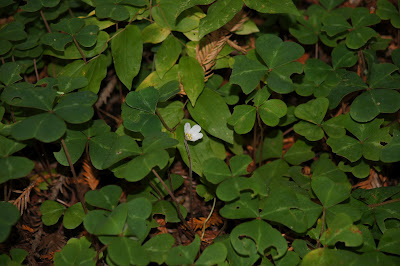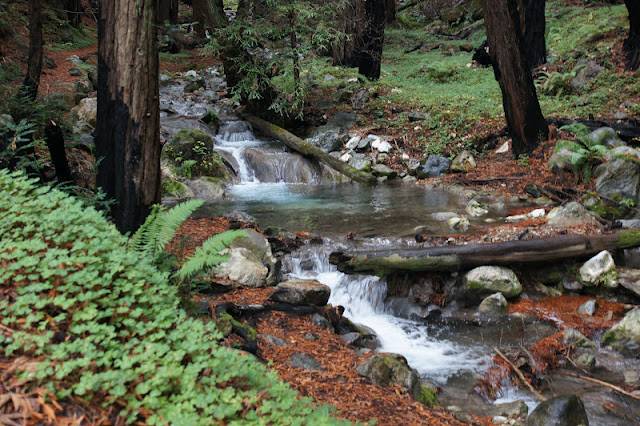Place: Limekiln State Park at Big Sur, California
Coordinates: 36.0085, -121.5181
Date: November 24, 2012
Difficulty: easy.
On 2011 Thanksgiving break we planned to visit the coastal redwoods up north at Redwood National Park but the weather forecast made us change direction, so we traveled south to sunny Santa Barbara. On our way we did a lot of sightseeing as well as some hiking. We spent half a day hiking all of the two-miles trail system of Limekiln State Park in a nearly constant drizzle and had a great time.
Limekiln State Park is in the south region of the Big Sur - that mountainous landmass looming between Monterey and San Simeon. The Big Sur slopes steeply into the Pacific Ocean, creating the owe-inspiring coastline of the famous highway 1 scenic route.
Most of the Big Sur is part of the Los Padres National forest. There are, however, several state parks in that region along highway 1. Linekiln State Park is near the south part of the Big Sur, close to San Simeon. It is a small park with only three trails, all of then easy and all of them combined are just under two miles.
It was overcast and drizzling when we arrived but we were already tired of sitting in the car so we went hiking despite the rain. Naturally, I kept my camera hidden under my poncho most of the time. I did, however, use it often, so do forgive the droplet spots that appear on some of the photos.
My first and strongest impression of the place was:
Red! Green!
 |
| Redwood trunks and red-littered forest floor. |
A lush
redwood forest is exactly that: the bottom forest floor red with fallen
redwood foliage and thick red trunks supporting a distant canopy. In
contrast, the hill slopes are green with mosses, ferns and other small vegetation.
 |
| Dark forest floor carpeted with red fallen redwood leaves |
 Fungi make a crucial link in the forest life cycle. They are essential to the process of disintegrating dead wood and other organic matter and releasing the nutrients back into the soil, thus making them once more available for living plants.
Fungi make a crucial link in the forest life cycle. They are essential to the process of disintegrating dead wood and other organic matter and releasing the nutrients back into the soil, thus making them once more available for living plants.  There are so many kinds of fungi, and all of them are beautiful. The wet season is, of course, the best time to see them. That is when they form the above-ground fruiting bodies and release their spores.
There are so many kinds of fungi, and all of them are beautiful. The wet season is, of course, the best time to see them. That is when they form the above-ground fruiting bodies and release their spores.  Our older chica is fascinated with mushrooms. She insists on us photographing each and every one we encounter on our hikes. After this particular hike we got her a camera of her own :-)
Our older chica is fascinated with mushrooms. She insists on us photographing each and every one we encounter on our hikes. After this particular hike we got her a camera of her own :-) The main trail leads directly to the lime kilns - the historical part of this park. We, however, first took the second branching trail southward towards the falls. The creeks were all flowing strongly, and we had to ford the water more than once, often wetting our feet.
The main trail leads directly to the lime kilns - the historical part of this park. We, however, first took the second branching trail southward towards the falls. The creeks were all flowing strongly, and we had to ford the water more than once, often wetting our feet.
The trail was crawling with bright yellow stripes - banana Slugs - the only animals we've encountered the entire hike. We had to take great care not to step on any.
 |
| Banana slug |
Banana slugs are quite large - we've seen some as long as an adult hand. They need the wet conditions to move around, eat and mate. They are common throughout California, but in many places they are already mixed with the invasive gray European slug. It was nice to see the bright colors of this California native.
 |
| Cute, isn't it? |
We encountered many fallen trees across our path and we had to climb over or crawl under them.
Most of the time it felt like walking an obstacle course but some time the fallen logs came in handy when we needed to cross the creek.
My impression was that the trail was not being maintained. Not well, anyway. This has added some interesting challenges to our hike but also gave the entire area a more wild appearance, and a great deal of excitement for the chicas.

The trail leading to the falls is only 0.2 mile long, but the obstacles slowed us down considerably. Eventually, we did reach our desired destination:
 |
| Limekiln falls |

There wasn't much room to stand near the falls and we crossed the creek once more to reach a small graveled area where we could sit and eat our snacks, and enjoy the view and the misty spray of the falls.

After we took our rest we backtracked to the main trail, which was much better kept and continued east to the kilns. There were more redwoods along the main creek. The little chica enjoyed sneaking into the hollow ones:
The big trunk's bottoms painted green with lichen and moss:

We also seen the evidence of a past fires:

And eventually we did see a real flower!
 |
| Redwood Sorrel |
 |
| The lime kilns |
 |


Upon returning to the first branching trail the chicas were already tired so I left them with Papa quail to continue to the parking lot and I went to explore that side trail by myself.
 |
| A fallen tree cascade |

I might have appreciated this trail more if I wasn't conscious of my waiting family. The trail dead-ended in a pile of fallen logs and forest litter and I turned around and hurried back.
By that time the rain has intensified. We had a quick, wet lunch and returned to the car. Limekiln State Park also features a beach and a campground but we have decided to save those for a drier visit.
We enjoyed the hike very much. Rain or shine, this beautiful park is definitely on our 'visit again' list!




































